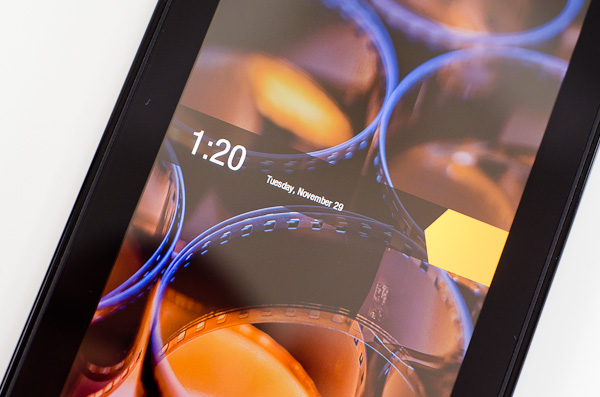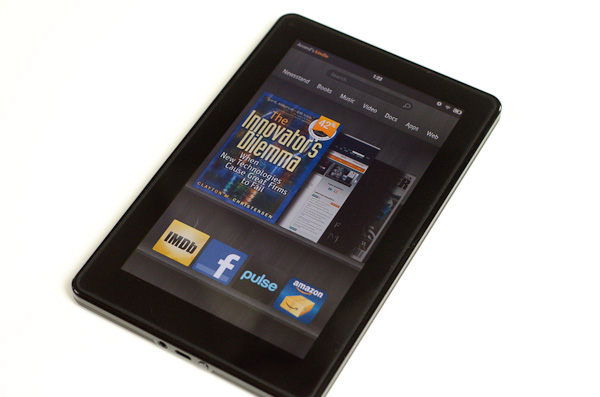Amazon Kindle Fire Review
by Anand Lal Shimpi & Vivek Gowri on November 29, 2011 3:31 AM EST- Posted in
- Tablets
- Mobile
- Amazon
- Kindle Fire
- Kindle
Final Words
The Kindle Fire is probably the best tablet you can buy at $199. Amazon has effectively defined the new price point and specs for entry level tablets, anything comparable shouldn't even bother with a price tag greater than $199. I'm sure this won't come as welcome news to players in the Android space looking to enjoy Apple-like profit margins, but sometimes the truth is hard to hear.
At $199, Amazon is giving you some of the fastest mobile hardware money can buy today. The reason the Kindle Fire isn't a must buy for everyone is because the software experience layered on top of the hardware isn't yet perfect. The OS is clean and easy to navigate but the UI isn't always smooth, interactions aren't always responsive and the browser isn't as pleasant as what you can get from iOS or newer versions of Android.
The counterpoint is that for $499 you can get this software experience, while at $199 you obviously have to give something up. I'd argue that you shouldn't have to give anything up. Much of the software experience I'm asking for is already baked into current or close-to-shipping versions of Android today. Amazon picked an earlier point in the curve to fork from Android, but what I'm asking for is technically possible today. Amazon did the right thing by including the best hardware possible in the Kindle Fire, it simply needs to follow through on the software side to truly unlock it.
Amazon does deserve points for a job well done in a number of areas. First and foremost, the Kindle Fire's version of Android is really well executed. While there are some navigational hiccups, the experience overall is quite good. I would strongly encourage major players in the Android space to look at what Amazon has done when they are considering their own customizations to Google's OS. Yes, sometimes less is actually more.
As much as I'm not a fan of the Silk browser today, I can see where things could go. I do believe that Amazon really wants to deliver the full tablet experience in a device the size of a regular Kindle. Moore's Law will eventually give us that reality, but Amazon may be able to speed things up by moving much of the heavy lifting into the cloud. I do hope this is the future Amazon is working towards and Silk's cloud-side caching isn't solely a power grab for behavioral data.
The integration of Amazon Prime video streaming and the Amazon stores is extremely well done. If you're an Amazon addict, the Kindle Fire will likely do horrible things to your bank account.
I feel like Amazon believes in the Kindle Fire and thus we will see the software get better over time. As with most tablet recommendations lately, if you can wait, doing so would be wise. Don't assume that things will get better, wait for Amazon to make them better and then reward the company with your hard earned dollars.
That being said, more concrete recommendations are always nice so here we go:
1) If all you do is read eBooks, grab a regular Kindle. The reading experience is far better on those devices. Sure response time is noticeably longer than on the Kindle Fire, but you do get better battery life, a display that's easier on your eyes, etc...
2) If you already have an iPad/Honeycomb tablet, look elsewhere. I appreciate you reading this review but don't buy a Kindle Fire. If you really want something more portable to read books on, see point 1.
3) If you need an entry level tablet, the Kindle Fire is as good as they get for $199. You get the same general purpose compute and memory as an iPad 2, at a far lower price. GPU performance isn't a knockout but as long as you're not a hardcore 3D gamer (do those exist on Android yet?) or high end game developer this isn't an issue.
I'm curious to see how this plays out. The e-ink Kindle has a unique (perfect?) form factor and delivers a pretty good experience. The Kindle Fire has a more generic form factor (perhaps too small for certain uses?) and delivers a varied experience depending on what you're doing. I appreciate what Amazon is trying to do here: good tablet experiences shouldn't cost as much as much higher performing computing devices, and cheap tablets shouldn't sacrifice everything to get there. The Kindle Fire is Amazon's first attempt at bridging the gap between those two extremes. It's the best out today given its price point, but it's not the best Amazon could have done. I'm waiting for round two.












70 Comments
View All Comments
doobydoo - Thursday, December 8, 2011 - link
Who buys both an iPad AND an Android tablet, particularly given your irrational dislike for tablets?Very ignorant comments you make.
Kindle Fire IS trying to accomplish some of the same tasks that the iPad does. Eg web browsing - the key part of functionality in the iPad.
The probem is, it does it worse, because it is too small.
iPad and droid tablets are not trying to accomplish what 'laptops do well', at all. They are alternative, lightweight and more simple alternatives when it comes to accessing the web and apps, predominantly. And they do that exceptionally well. There are millions of people who bought them with realistic expectations and therefore kept them, only people with illogical hopes such as the tablet being a work-computer replacement would come away disappointed, and I would be curious which part they didn't realise would happen before they bought?
If anything is a 'tweener' - it's this Kindle Fire. It does the web / app thing - badly. It does the book thing - badly. It's an attempt to combine the best of both worlds, jack of all trades, master of none kind of story.
Which explains why it's cheap.
As for knocking Apple for bringing out devices in 6-12 months (when they have an annual so clearly not a 6 month life-cycle) - how ironic? Lets look at the Kindle release path:
Kindle 2 - Feb 10th, 2009
Kindle DX - July 1st, 2010
Kindle 3rd Gen - July 28th, 2010
Kindle 4th Gen - Sep 28th, 2011
Just over 2 years, 4 products. Ironic much?
It isn't just Apple fanboys who appreciate the use of tablets - it's just people who aren't so ridiculously stupid that they expect a tablet to be a PC. They know what it is, realise its place, and benefit from it enormously.
haukionkannel - Tuesday, November 29, 2011 - link
Well, I am more of e-ink friend because I wan to read books form my tablet. But the option to read allso net pages would be nice, so I am really much vaiting for coulour e-inks displays!They are stin under development, but offer superior display quality over LCD dispays. The problem is speed, so no fast games to colour e-ink, but the consume very little power and offer cood readability to the text!
RandomUsername3245 - Tuesday, November 29, 2011 - link
About 12 months ago I held a prototype color eInk touchscreen display after a talk by an eInk Corporation employee. It was quite impressive, but the color isn't quite up to glossy magazine / photograph quality, and, like you said, it ran at about 12 frames per second.e-Ink consumes power only when switching pages, so when it starts to run at higher frame rates it becomes much less efficient. e-Ink is great when you switch pages every few seconds when reading a page of text, but if you were asking it to play 10 fps animation or support quick-refresh page scrolling, I don't think it would offer much benefit over LCD.
NorthstarNerd - Tuesday, November 29, 2011 - link
I own both an iPad 1 and a Kindle Fire. Both are good products, but different. I'm amazed how much my Fire can do at $300 less than an iPad. Having said that I HATE the Amazon Carousel, and quickly learned how to get rid of it w/o rooting the device!http://www.northstarnerd.org/econtent/2011/11/pers...
genomecop - Thursday, December 1, 2011 - link
No problem on the install, but Kindle Books wont launch from Go Launcher.PeteH - Thursday, December 8, 2011 - link
Keep in mind the iPad is a previous generation of hardware, and I think it's a little misleading to compare the price points and capabilities of products from different generations. Newer generations of technology always do more for less money.adamantinepiggy - Tuesday, November 29, 2011 - link
Hand the Fire to anyone who has never played with one. First thing they invariably do is bump the power button with their hand. Rest the device against your chest (like when you are reading lying down), 1st thing that happens is power button gets bumped. Look at it wrong and I swear the power button gets bumped by ocular telekinesis magic. Yes you could flip the thing upside down, but having to perform tablet acrobatic to compensate for a crappy layout is stupid.It seems not one single person bothered to QA the button design when all that was needed was to move it, or cheaper still, make it recessed or much stiffer.
Stuffster - Tuesday, November 29, 2011 - link
This review has almost everything I could ask for. But it's missing one of the most important questions I have: what about privacy?How effectively can I use the Fire as an e-reader without providing any personal information - for example, can I just provide a username, password, and something like a one-time-use credit card?
Smartphones, tablets, and e-readers aren't exactly friendly in this regard. I'd love for reviews of these devices to include a page dedicated to the matter of privacy.
cbdoc - Tuesday, November 29, 2011 - link
You can choose to not have your CC/account info saved on the device making one-time purchases possible.Stuffster - Tuesday, November 29, 2011 - link
That's good, but this is an Android-based device. Is it necessary to have a Google account to use it (which would mean providing your real name and birthdate, if nothing else)?